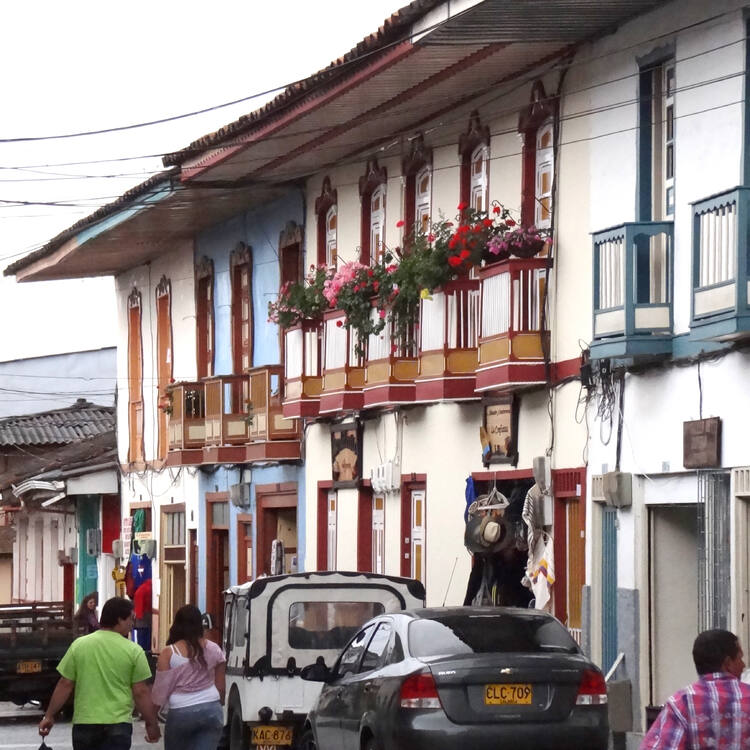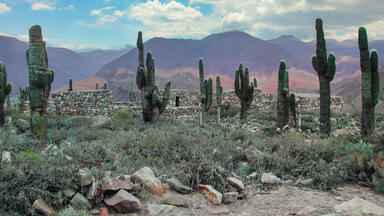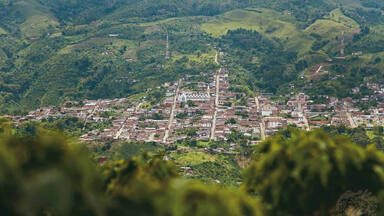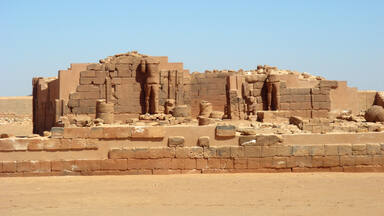Coffee Cultural Landscape of Colombia
Coffee Cultural Landscape of Colombia
An exceptional example of a sustainable and productive cultural landscape that is unique and representative of a tradition that is a strong symbol for coffee growing areas worldwide - encompasses six farming landscapes, which include 18 urban centres on the foothills of the western and central ranges of the Cordillera de los Andes in the west of the country. It reflects a centennial tradition of coffee growing in small plots in the high forest and the way farmers have adapted cultivation to difficult mountain conditions. The urban areas, mainly situated on the relatively flat tops of hills above sloping coffee fields, are characterized by the architecture of the Antioquian colonization with Spanish influence. Building materials were, and remain in some areas, cob and pleated cane for the walls with clay tiles for the roofs.
Description is available under license CC-BY-SA IGO 3.0
Paysage culturel du café de la Colombie
Le paysage culturel du café de Colombie est un exemple exceptionnel d'un paysage culturel productif et durable qui est unique et représentatif d'une tradition devenue un symbole fort en Colombie mais aussi dans d'autres régions caféières du monde. Le bien comprend six paysages agricoles et 18 centres urbains situés au pied des collines des chaines orientale et centrale de la cordillère des Andes, dans l'ouest du pays. Il reflète une tradition centenaire de la culture du café sur de petites parcelles prises sur la haute forêt et la façon dont les paysans ont adapté la culture au difficile environnement montagneux. Les zones urbaines, situées principalement sur les plateaux au sommet des collines surplombant les plantations de café, sont caractérisées par l'architecture de la colonisation d'Antioquia, influencée par le style espagnol. Les matériaux de construction étaient, et demeurent dans certaines zones, le torchis et les cannes tressées pour former les murs tandis que les toits sont constitués de tuiles d'argile.
Description is available under license CC-BY-SA IGO 3.0
المشهد الثقافي للقهوة الكولومبيا
هو نموذج استثنائي لمشهد القهوة الثقافي المستدام والمنتج، الفريد من نوعه والذي يمثل تقليدًا متوارثًا، وبالتالي هو رمز صارخ لحقول البن التي تنمو في العالم، ويشمل ست مناطق زراعية تحوي 18 مركزًا حضريًّا على سفوح السلاسل الغربية والوسطى من دي لوس كورديليرا في جبال الأنديز، غرب البلاد. وهو يعكس تقليدًا يرقى إلى مئة سنة لزراعة البن في مساحات صغيرة في غابة عالية، وكذلك تكيف المزارعين مع الظروف الزراعية الجبلية الصعبة. وتقع المناطق الحضرية أساسًا على قمم مسطحة نسبيًّا تشرف على التلال المنحدرة المزروعة بنًّا، وهي تتميز بهندسة معمارية أنتوكية من زمن الاستعمار الإسباني. وكانت مواد البناء، التي لا تزال معتمدة في بعض المناطق، تتألف من شذرات سنابل الذرة وثنيات القصب للجدران، وقطع من الطين للسقوف.
source: UNESCO/CPE
Description is available under license CC-BY-SA IGO 3.0
哥伦比亚咖啡文化景观
是可持续的并且富有生产能力的文化景观的杰出代表,同时它也代表着一项独一无二的传统,一项对于全世界的咖啡种植区来说都具有强烈涵义的传统。这一遗产位于哥伦比亚西部安第斯山脉的中西部山麓之间,由6处农业景观和18个城市中心所组成。这里上百年的咖啡种植传统主要表现为在乔木林中进行小块种植,以及当地农民为了克服高山环境的不利影响所采取的独特咖啡种植方式。景观内的城区主要位于相对平坦的山顶,山顶下方的坡地则分布着咖啡田。城区建筑以受西班牙影响的安蒂奥基亚(Antioquia)殖民建筑为主。这些建筑采用的建筑材料——也是今天有些地区仍旧采用的建筑材料,是用来做墙壁的掺有禾秆的黏土砂浆和压缩过的甘蔗,以及用来做屋顶的粘土瓦。
source: UNESCO/CPE
Description is available under license CC-BY-SA IGO 3.0
Кофейный культурный ландшафт Колумбии
выдающийся образец устойчивого и продуктивного культурного ландшафта. Является уникальным и представляет выразительный символ традиции, характерной для районов выращивания кофе во всем мире. Территория включает шесть сельскохозяйственных районов с 18 городскими центрами в предгорьях западного и центрального хребтов Анд (Cordillera de los Andes) на западе страны. Здесь находят отражение вековая традиция выращивания кофе на небольших участках в высокоствольном лесу и способы, которыми фермеры приспосабливают ведение сельского хозяйства к тяжелым горным условиям. Архитектура городских районов, расположенных, главным образом, на вершинах относительно пологих холмов над сбегающими по склонам кофейными плантациями, отличается испанским влиянием периода колонизации. Строительными материалами того времени были, а в некоторых местах остаются, глина и гнутые стебли тростника для стен и глиняная черепица для крыш.
source: UNESCO/CPE
Description is available under license CC-BY-SA IGO 3.0
El Paisaje cultural del café de Colombia
Es un ejemplo excepcional de paisaje cultural sustentable y productivo único que representa una tradición que representa un símbolo poderoso tanto a nivel nacional como para otras zonas cafetaleras del mundo. Incluye seis paisajes cafetaleros y dieciocho centros urbanos de las cadenas occidental y central de la Cordillera de los Andes, al oeste de Colombia. Estos paisajes son reflejo de una tradición centenaria consistente en cultivar en pequeñas parcelas de bosque alto y del modo en que los cafetaleros adaptaron el cultivo a las condiciones difíciles de la alta montaña. Las zonas urbanizadas, en su mayoría situadas en las cumbres de las colinas, se caracterizan por una arquitectura creada por los colonos procedentes de la región de Antioquia, de influencia española. Como materiales de construcción se utilizaron materiales tradicionales, tales como tapia, bahareque (cañas trenzadas) para los muros y tejas de arcilla para los tejados. Algunos de estos materiales persisten todavía en algunas zonas.
source: UNESCO/CPE
Description is available under license CC-BY-SA IGO 3.0
コロンビアのコーヒー産地の文化的景観
持続的に生産が続いている文化的景観で、世界的に知られたコーヒー生産を象徴する顕著な事例である。コロンビア西部にあるアンデス山脈の西側と中央部の麓にある6つの農業景観からなり、18の都市を含む。高地の狭小な土地で100年も続くコーヒー生産の伝統と、厳しい山地環境に適した耕法が見られる。都市部は、コーヒー畑の上にある比較的平坦な丘の頂上に位置し、アンティオキア州のスペイン植民地時代の建築が特徴である。建物の壁には、練り土とトウモロコシの穂軸、屋根には粘土瓦が使用されてきた。source: NFUAJ
Koffiecultuurlandschap van Colombia
Het koffielandschap van Colombia is een voorbeeld van een duurzaam, productief cultuurlandschap en een symbool voor koffieplantages wereldwijd. Het gebied omvat zes landbouwlandschappen, waaronder 18 stedelijke centra op de uitlopers van de westelijke en centrale gebieden van Cordillera de los Andes. Het landschap toont een honderdjarige traditie van koffieteelt op kleine percelen in hoge bergbossen en de manier waarop boeren de teelt hebben aangepast aan de moeilijke omstandigheden. De stedelijke gebieden worden gekenmerkt door de architectuur van de Antioquia kolonisatie, met Spaanse invloeden. Bouwmaterialen waren – of zijn in sommige gebieden – maïskolven en geplooid riet voor de muren en kleitegels voor de daken.
Source: unesco.nl
Outstanding Universal Value
Brief synthesis
The Coffee Cultural Landscape of Colombia (CCLC) is a continuing productive landscape consisting of a series of six sites, which integrate eighteen urban settlements. The property illustrates natural, economic and cultural features, combined in a mountainous area with collaboratively farmed coffee plantations, some of these in clearings of high forest.
The CCLC is the result of the adaptation process of Antioquian settlers, who arrived in the 19th century, a process which persists to this day and has created an economy and culture deeply rooted in the coffee production tradition. Coffee farms are located on steep mountains ranges with vertiginous slopes of over 25% (55 degrees), characteristic to the challenging coffee terrain. These unusual geographic features also affect the small orthogonal plot layouts, and influence the architectural typology, lifestyle and land-use techniques of the cafeteros (coffee farmers). The distinctive way of life of the cafeteros is based on legacies that have been passed down from generation to generation, and is linked to their traditional landownership and the distinctive small farm production system.
The typical architecture in the urban settlements is a fusion between the Spanish cultural patterns and the indigenous culture of the region adapted as well to the coffee growing process, through for example their sliding roofs. Houses function as both dwelling units and centers of economic activity, with walls built in the traditional, more flexible and dynamic ‘bahareque’ constructive system, and covered by a layer of bamboo well known for its resistance and malleability. Over fifty percent of the walls are still built using this traditional method.
Criterion (v): The CCLC is an outstanding example of continuing land-use, in which the collective effort of several generations of campesino families generated innovative management practices of natural resources in extraordinarily challenging geographical conditions. The strong community focus on coffee production in all aspects of life produced an unparalleled cultural identity, which finds its physical expression in the cultural patterns and materials used for coffee farming as well as the urban settlements.
Criterion (vi): The coffee tradition is the most representative symbol of national culture in Colombia, for which Colombia has gained worldwide recognition. In the CCLC this coffee culture has led to rich tangible and intangible manifestations in the territory, with a unique legacy, included in, but not limited to, the harmonious integration of the productive process in the social organization and housing typology, and communicated though associated local traditions and costumes, such as the sombrero aguadeño – a traditional type of hat – and the raw hide shoulder bag, still used by the coffee producers.
Integrity
The six site components of the CCLC are located in what is known as the Eje Cafetero, or coffee growing axis, a region that is characterized by the social and cultural characteristics of the coffee landscape and production. The site components of the property provide localized glimpses into production activities and landscape features, which equally dominate the wider setting and region. To facilitate the understanding of this exceptional landscape, the property’s elements of social adaptation to a unique use of land, and the development of highly specific cultural and social traditions in both agricultural practices and arrangement of settlements, contribute to the complete image of a continuing, productive and living landscape. The continuity of traditional small plot coffee farming, often run in family units, and the strong linkages to the associated cultural traditions contribute to the integrity, but are vulnerable to fluctuations in the international coffee market prices and resulting economic pressures. The integrity of the property would also be negatively affected by gold mining activities.
Authenticity
The Coffee Cultural Landscape of Colombia is an authentic reflection of a centenary process of man’s adaptation to challenging geographical and climatic conditions of this area, known as the Eje Cafetero. The CCLC contains very few contemporary incongruous additions to its traditional architectural and landscape patterns, and no substantial modifications to the small towns located in the property as well as in the buffer zone. Aspects such as traditions, language and other forms of intangible heritage, have been preserved, mostly by owners and the local community, who have a high sense of social appropriation of their cultural heritage.
Protection and management requirements
While the traditional land-use patterns of the CCLC are legally protected, the legal protection of the property area is provided through the land-use plans. Further legal protection of the six component sites as cultural heritage sites may be desirable. An additional basis for some of the protection mechanisms is customary law and governance integrating customary management. The property would benefit from a better integration of these customary practices with the formal protection and management provisions.
The management of the CCLC is coordinated by a management committee, which was established by the Ministry of Culture, the Colombian Coffee Growers Federation (FNC), the Governors of Caldas, Quindío, Risaralda and Valle or their delegates, representatives of the Coffee Growers and universities. An Executive Director was appointed to oversee the implementation of the management system, which is guided by a management plan, developed with the support of the Centre for Regional, Coffee and Business Studies (CRECE).
Within the management framework, strong emphasis is given to the economic and social well-being of the inhabitants and coffee farmers, their appropriation of the cultural heritage, and environmental sustainability of the coffee production in the living cultural landscape. Although the management plan does address some of the predominant pressures, including inappropriate development, gold mining, changes to local farming traditions through inappropriate use of pesticides, fertilizers, waste-water processing and soil erosion, the respective land use plans yet need to be integrated with and adjusted to the management plan objectives and additional legislation is required for the semi-urban and rural area traditional buildings, which contribute to the significance of the CCLC.




